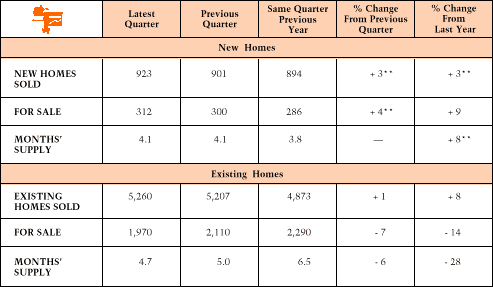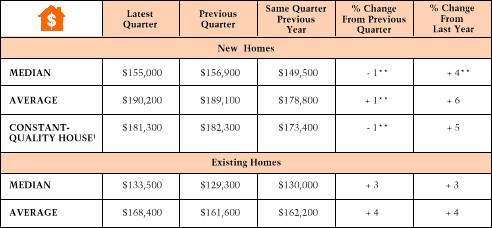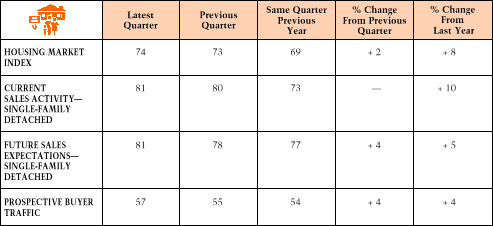|
HOUSING MARKETING
 Home Sales* Home Sales*
Sales of new single-family homes totaled 923,000 units at a seasonally adjusted annual rate (SAAR) in the second quarter of 1999, up a statistically insignificant 3 percent from the previous quarter and up a statistically insignificant 3 percent from the second quarter of 1998. The number of new homes for sale at the end of June 1999 was 312,000 units, up a statistically insignificant 4 percent from the previous quarter and up 9 percent from the second quarter of 1998. At the end of June, inventories represented a 4.1 months' supply at the current sales rates, no change from the first quarter of 1999 and up a statistically insignificant 8 percent from the second quarter of 1998.
Sales of existing single-family homes for the second quarter of 1999 reported by the NATIONAL ASSOCIATION OF REALTORS® totaled 5,260,000 units at a seasonally adjusted annual rate (SAAR), up 1 percent from the first quarter of 1999 and up 8 percent from the second quarter of 1998. The number of units for sale at the end of the second quarter was 1,970,000, 7 percent below the previous quarter and 14 percent below the second quarter of 1998. At the end of the second quarter, a 4.7 months' supply of units remained 6 percent below the previous quarter and 28 percent below the second quarter of 1998.
 *Units in thousands.
*Units in thousands.
**This change is not statistically significant.
Sources: New: Bureau of the Census, Department of Commerce; and Office of Policy Development and Research, Department of Housing and Urban Development
Existing: NATIONAL ASSOCIATION OF REALTORS® |
 Home Prices Home Prices
The median price of new homes during the second quarter of 1999 was $155,000, down a statistically insignificant 1 percent from the previous quarter's level but above the second quarter of 1998 by 4 percent. The average price of new homes sold during the second quarter of 1999 was $190,200, up a statistically insignificant 1 percent from the first quarter of 1999 and up 6 percent from the second quarter a year ago. The price adjusted to represent a constant-quality house was $181,300, down a statistically insignificant 1 percent from the first quarter of 1999 but up 5 percent from the second quarter of 1998. The values for the set of physical characteristics used for the constant-quality house are based on 1992 sales.
The median price of existing single-family homes in the second quarter of 1999 was $133,500, up 3 percent above the previous quarter and 3 percent above the second quarter of 1998, according to the NATIONAL ASSOCIATION OF REALTORS®. The average price of $168,400 was up 4 percent from the previous quarter and up 4 percent from the second quarter of 1998.
 **This change is not statistically significant.
**This change is not statistically significant.
1A constant-quality house has the same physical characteristics from year to year and its price is estimated using statistical models.
Sources: New: Bureau of the Census, Department of Commerce; and Office of Policy Development and Research, Department of Housing and Urban Development
Existing: NATIONAL ASSOCIATION OF REALTORS® |
 Housing Affordability Housing Affordability
Housing affordability is the ratio of median family income to the income needed to purchase the median-priced home, based on current interest rates and underwriting standards expressed as an index. The NATIONAL ASSOCIATION OF REALTORS® composite index value for the second quarter of 1999 shows that families earning the median income have 134.3 percent of the income needed to purchase the median-priced existing home. This figure is down 4 percent from the first quarter of 1999 but was unchanged from the second quarter of 1998.
The decline in the housing affordability index is the result of changes in the marketplace. The national average home mortgage interest rate for existing single-family homes has risen 18 basis points from the previous quarter to an interest rate of 7.13 percent. The median price of existing single-family homes rose 3 percent in the second quarter with most of the increase occurring in the month of June with the median price increasing 5 percent above May's price. The median family income, rising less than 1 percent during the second quarter, has not kept pace with the increases in mortgage interest rates and housing prices.
The fixed-rate index decreased 4 percent from the first quarter of 1999 but was unchanged from the second quarter of 1998. The adjustable-rate index decreased 3 percent from the previous quarter but rose 1 percent from the same quarter a year earlier.
 Source: NATIONAL ASSOCIATION OF REALTORS®
Source: NATIONAL ASSOCIATION OF REALTORS® |
 Apartment Absorptions Apartment Absorptions
There were 47,200 new, unsubsidized, unfurnished, multifamily (five or more units in structure) rental apartments completed in the first quarter of 1999, down a statistically insignificant 3 percent from the previous quarter but up a statistically insignificant 4 percent from the first quarter of 1998. Of the apartments completed in the first quarter of 1999, 72 percent were rented within 3 months. This absorption rate is a statistically insignificant 1 percent below the previous quarter and 5 percent below the same quarter in the previous year. The median asking rent for apartments completed in the first quarter was $761, which is a statistically insignificant 1 percent below the previous quarter but a statistically insignificant 3 percent above a year earlier.
 *Units in thousands.
*Units in thousands.
**This change is not statistically significant.
Sources: Bureau of the Census, Department of Commerce; and Office of Policy Development and Research, Department of Housing and Urban Development
|
 Manufactured (Mobile) Home Placements Manufactured (Mobile) Home Placements
Manufactured homes placed on site ready for occupancy in the first quarter of 1999 totaled 370,000 at a seasonally adjusted annual rate, a statistically insignificant 1 percent below the level of the previous quarter but a statistically insignificant 1 percent above the first quarter of 1998. The number of homes for sale on dealers' lots at the end of the first quarter totaled 91,000 units, unchanged from the previous quarter but 2 percent below the same quarter of 1998. The average sales price of the units sold in the first quarter was $43,200, a statistically insignificant 5 percent below the previous quarter and a statistically insignificant 4 percent above the first-quarter 1998 price.
 *Units in thousands. These are HUD-code homes only and do not include manufactured housing units built to meet local building codes, which are included in housing completions figures.
*Units in thousands. These are HUD-code homes only and do not include manufactured housing units built to meet local building codes, which are included in housing completions figures.
**This change is not statistically significant.
Sources: Bureau of the Census, Department of Commerce; and Office of Policy Development and Research, Department of Housing and Urban Development
|
 Builders' Views of Housing Market Activity Builders' Views of Housing Market Activity
The National Association of Home Builders (NAHB) conducts a monthly survey focusing on builders' views
of the level of sales activity and their expectations for the near future. NAHB uses these survey responses to construct indices of housing market activity. (The index values range from 0 to 100.) The second-quarter value for the index of current market activity for single-family detached houses stood at 81, up 1 point from the first quarter and up 8 points from 1998's second quarter. The index for future sales expectations, 81, was up 3 points from the first-quarter value and up 4 points from 1998's level. Prospective buyer traffic had an index value of 57, which is up 2 points from the first-quarter value and up 3 points from 1998's second-quarter level. NAHB combines these separate indexes into a single housing market index that mirrors the three components quite closely. In the second quarter, this index stood at 74, which is up 1 point from the first-quarter level and up 5 points from the value in 1998.
 Source: National Association of Home Builders, Builders Economic Council Survey
Source: National Association of Home Builders, Builders Economic Council Survey |
|

